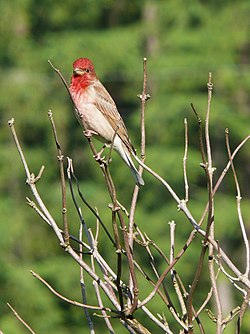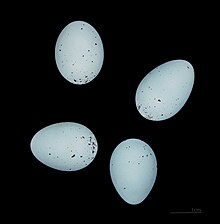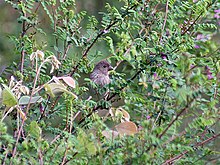Carmine pickle (species)
| Carmine | ||||||||||||
|---|---|---|---|---|---|---|---|---|---|---|---|---|

Carrion Pickle ( Carpodacus erythrinus ) |
||||||||||||
| Systematics | ||||||||||||
|
||||||||||||
| Scientific name | ||||||||||||
| Carpodacus erythrinus | ||||||||||||
| ( Pallas , 1770) |
The carmine pickle ( Carpodacus erythrinus ) is a songbird belonging to the finch family (Fringillidae).
description
The carmine is up to 15 centimeters long and weighs about 20 to 25 grams. In the case of the colored male, the head, breast and rump have a characteristic crimson color. Females and males in the second calendar year are dull olive-brown on top with two narrow, rust-beige wing bands. Young birds look similar, but are more intense olive-brown and with more distinct rust-beige wing bands and umbrella feather tips. The belly is whitish, the eyes dark and the beak powerful.
The call sounds soft “woe” or “djü” and is somewhat reminiscent of that of the green . The song is catchy, oriole-like whistling and falling at the end. The singing is usually performed from an elevated position. The females can also sing.
habitat
The carmine pickle lives in a wide variety of habitats. The populations in Central Europe breed mostly in semi-open landscapes or sparse stands of trees with a well-developed layer of shrubs and herbs: z. B. light floodplain and swamp forests , deciduous and mixed forests and clearings, groups of trees and bushes in rain bogs , siltation zones; but also drier locations with shrub growth, sometimes in park-like landscapes, on the edges of settlements or in mountain meadows.
The eastern populations (Asia) are often found in city parks and come up to the upper edge of the tree line, while the northwest populations (Finland, Sweden) have their focus in deciduous trees.
In all cases, a well-developed bush structure and, if possible, lush, diverse vegetation (therefore often occurring in damp places) are relevant.
behavior
The carmine is territorial during the breeding season, but the birds behave inconspicuously (no nest defense, often absence of males). Possibly this should avoid the conspicuousness or the risk of a clutch loss. The carmine is diurnal.
Reproduction
The species often breeds in groups. The nest is built low, well hidden in the thick bushes. The breeding season extends from early June to July. The female usually lays four to six eggs , which are sparsely dark brown, black-brown or dark purple spotted and dashed on a blue background, heaped on the blunt pole. The breeding season is eleven to 14 days. The female is fed only a little by the male. The young birds fledge after 12 to 13 days.
nutrition
The carmine is primarily vegetarian, with seeds and buds from bushes and deciduous trees dominating. The food of the nestlings is also predominantly vegetable. Animal food makes up only a small proportion and includes spiders, caterpillars, beetles, etc. with a focus on June.
Distribution area, hikes
The distribution area of the carmine sparrow stretches from Kamchatka along the Pacific coast in the east to Central Europe in the west, in the south with gaps in the mountain systems of the Caucasus, the Altai and the Himalayas.
The carmine is a long-distance migrant (also medium- distance migrant in the eastern populations ) with its main winter quarters in north and central India to south-east China. The breeding birds of Europe reach their winter quarters via east and south-east migration, although little details are known so far. Breeding birds from Asia Minor may already overwinter in Iran. Young birds can initially migrate to the northwest over the area in autumn (as far as the North Sea area). Some late as well as early observations in Central Europe may be related to the emergence of new wintering areas in Africa and the Near East. In Central Europe, the emigration takes place immediately after the young have fled out from mid-July, individual birds remain until around the end of August. The return to the western breeding areas is usually relatively constant: the older males between May 15 and 20, younger males and females a little later. The carmill is one of the latest migratory bird species to arrive in Central Europe. The breeding site loyalty is usually high.
The western spread of the carmine raspberry as far as Central Europe is related to a wave that has been spreading since the 1930s, although this is locally different. An earlier wave of propagation to the west had already reached Central Europe in the early 19th century. The western spread of the carmine rush is still dynamic and since the beginning of the 1990s z. Sometimes subject to stagnation or a decline again. In the 2000s there was a decline on the Baltic Sea coast and in Bavaria.
Occurrence in Germany
The occurrence of the carmine rasp in Germany is on the western edge of its distribution. A contiguous distribution area in Germany for the reference years 2005 to 2009 only exists in Western Pomerania and along the Baltic Sea coast; there are also isolated distribution areas with the exception of the western federal states of Saarland, Rhineland-Palatinate and North Rhine-Westphalia. The population is estimated at 600 to 950 hunting grounds.
Subspecies
So far, five subspecies are known:
- Carpodacus erythrinus erythrinus ( Pallas , 1770) - The nominate form occurs in northern, central and eastern Europe as far as central Siberia .
- Carpodacus erythrinus grebnitskii Stejneger , 1885 - This subspecies occurs in eastern Siberia, northern Mongolia , northeast China and Korea .
- Carpodacus erythrinus kubanensis Laubmann , 1915 - This subspecies is found in Turkey , the Caucasus , northern Iran, and Turkmenistan .
- Carpodacus erythrinus ferghanensis ( Kozlova , 1939) - This subspecies is distributed in eastern Kazakhstan across western China, the western Himalayas , Pakistan and Afghanistan .
- Carpodacus erythrinus roseatus ( Blyth , 1842) - This subspecies is distributed in the central and eastern Himalayas to central and southern China.
Individual evidence
- ^ Lars Jonsson: The birds of Europe and the Mediterranean area. Edited by Peter H. Barthel. Franckh Kosmos Verlag, Stuttgart 1992, ISBN 3-440-06357-7 .
- ↑ a b c d e f g Hans-Günther Bauer, Einhard Bezzel, Wolfgang Fiedler: The compendium of birds in Central Europe. Everything about biology, endangerment and protection. Volume 2: Passeriformes - passerine birds. AULA-Verlag, Wiebelsheim 2005, ISBN 3-89104-648-0 .
- ↑ Siegfried Hoeher: clutch of birds from Central Europe and some species that breed in northern and southern latitudes. Neumann-Verlag, Radebeul 1973, page 120.
- ↑ a b K. Gedeon, C. Grüneberg, A. Mitschke, C. Sudfeldt, W. Eikhorst, S. Fischer, M. Flade, S. Frick, I. Geiersberger, B. Koop, M. Kramer, T. Krüger , N. Roth, T. Ryslavy, S. Stübing, SR Sudmann, R. Steffens, F. Vökler, K. Witt: Atlas of German breeding birds . Vogelmonitoring Deutschland Foundation and the umbrella organization of German Avifaunists, Münster 2014, ISBN 978-3-9815543-3-5 , pp. 646–647.
- ^ IOC World Bird List Finches, euphonias
Web links
- Singing carming pimple at www.vogelstimmen-wehr.de
- Carpodacus erythrinus in the endangered Red List species the IUCN 2008. Posted by: BirdLife International, 2008. Accessed January 30 of 2009.
- Videos, photos and sound recordings of Carpodacus erythrinus in the Internet Bird Collection
- Entry at the Swiss Ornithological Institute
- Feathers of the Carmine


